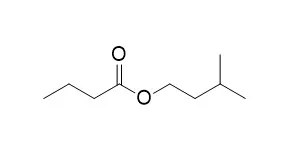| In vitro: |
| Sciences des Aliments,1996, 16(5):515-528. | | Volatile compounds from bananas. II - Comparative study of two extraction methods. Application to the pulp of banana: Cavendish, poyo.[Reference: WebLink] |
METHODS AND RESULTS:
Two extraction methods for volatile flavor compounds were tested using the pulp of banana (cavendish, poyo): 1) the simultaneous distillation and solvent extraction technique (SDE) which uses the LIKENS and NICKERSON device (L-N apparatus) and 2) the simultaneous purging and solvent extraction technique (SPE), using the apparatus developed by UMANO and SHIBAMOTO (U-S apparatus). A study was carried out with a L-N apparatus to test the volatile compounds concentration homogeneity and stability of a stock of fresh bananas, frozen bananas and frozen bananas after six weeks of storage at -80°C. We have chosen eight volatile compounds that characterize banana aroma (isobutyl and isoamyl alcohol; isobutyl, butyl, isoamyl acetate; isobutyl, butyl and Isoamyl butyrate), which may be used as main indicators of banana aroma. Extraction kinetics were obtained after 1, 2, 3, 4, 5 and 6 h extraction with the L-N apparatus and 2, 4, 6 et 8 h with the U-S apparatus.
CONCLUSIONS:
The extraction of four molecules (isoamyl alcohol, isoamyl acetate, Isoamyl butyrate and butyl butyrate), among the studied volatile compounds, proved to be better with the L-N device after 1 h of running than with the U-S apparatus after 8 h of running. | | Archives of Biological Sciences,2013: 65(3):877-883. | | Identification of bioactive components of essential oils in Heracleum sosnowskyi and Heracleum mantegazzianum (Apiaceae)[Reference: WebLink] | The contents and composition of essential oils obtained from and (Apiaceae) were examined.
METHODS AND RESULTS:
Essential oils were investigated by the GC/MS method. The composition of hogweeds' essential oils was examined in order to determine toxic compounds that could have a direct influence on the health of people and animals living in close proximity to both species. It was found that the essential oils, except for derivatives of coumarins, contain numerous toxic compounds, e.g. isobutyl isobutyrate, Isoamyl butyrate, hexyl hexanoate, 1-hexadecanol etc.
CONCLUSIONS:
No significant differences were found in the chemical composition of the examined seed samples of , which confirms the suggestions that the species can be closely related. |
|






 Cell. 2018 Jan 11;172(1-2):249-261.e12. doi: 10.1016/j.cell.2017.12.019.IF=36.216(2019)
Cell. 2018 Jan 11;172(1-2):249-261.e12. doi: 10.1016/j.cell.2017.12.019.IF=36.216(2019) Cell Metab. 2020 Mar 3;31(3):534-548.e5. doi: 10.1016/j.cmet.2020.01.002.IF=22.415(2019)
Cell Metab. 2020 Mar 3;31(3):534-548.e5. doi: 10.1016/j.cmet.2020.01.002.IF=22.415(2019) Mol Cell. 2017 Nov 16;68(4):673-685.e6. doi: 10.1016/j.molcel.2017.10.022.IF=14.548(2019)
Mol Cell. 2017 Nov 16;68(4):673-685.e6. doi: 10.1016/j.molcel.2017.10.022.IF=14.548(2019)